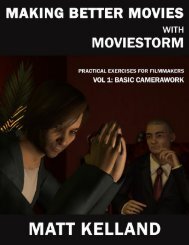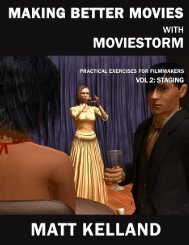Making Better Movies with Moviestorm Vol 3: Sound and Light
Making Better Movies with Moviestorm Vol 3: Sound and Light
Making Better Movies with Moviestorm Vol 3: Sound and Light
Create successful ePaper yourself
Turn your PDF publications into a flip-book with our unique Google optimized e-Paper software.
SILHOUETTES<br />
Technique<br />
Film an object in silhouette, for a dramatic effect.<br />
A silhouette can create a powerful visual composition. It can be used for shock or mystery. It can also be used as<br />
part of a reveal, where the audience initially sees only a shape, but then as the shot develops, more details can be<br />
made out. It is often used in horror or thrillers, but can have applications in other genres. It is of course a key<br />
element in many over the shoulder shots, where the front character is silhouetted. However, this effect needs to be<br />
used sparingly for best effect.<br />
Filming a silhouette is not the same as filming a shadow (covered in the next exercise). You are still filming the actual<br />
object, but <strong>with</strong> no front light (or very little front light) on it.<br />
Left: the silhouette through the doorway makes a strong image by compressing the visible screen area <strong>with</strong><br />
blackness. This would make a powerful opening or closing shot. Right: a very similar image filling the screen<br />
creates a completely different composition. Faint details are visible on the character, so it's not simply black.<br />
Take a scene in a single location – either interior or exterior. A very short scene<br />
is adequate for this: 30 seconds or less is sufficient. Dialog is not necessary.<br />
However, the scene must have some dramatic moment <strong>with</strong> someone or<br />
something appearing or a key prop such as a tombstone.<br />
39




